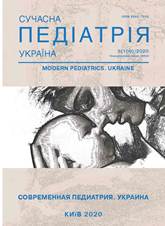Pompe disease: diagnostics and contemporary approaches of therapy
Keywords:
Pompe disease, diagnosis, treatmentAbstract
The article presents a clinical case of a child with an infantile form of Pompe disease. At the age of 5 months, the girl became ill with acute bronchitis and the gentle systolic murmur over the surface of the heart detected by the district pediatrician during auscultation was the reason for referral to a cardiologist. Echocardiography diagnosed hypertrophic cardiomyopathy and the child was hospitalized for further examination. The mother did not complain. Given the slightly reduced muscle tone, elevated levels of transaminases and hypertrophic cardiomyopathy, and after consultation with a neurologist and geneticist, it was decided to conduct a genetic examination. A pathogenic variant of p.1447G> A (p.Gly483Arg) was detected in the GAA gene in a homozygous state and a clinical diagnosis was made: Pompe disease, infantile classical form. One month after diagnosis, pre-existing human recombinant α-glucosidase replacement therapy was initiated. During 18 months of treatment, the child's condition was satisfactory, no adverse side effects from enzyme replacement therapy were recorded, but lysosomal glycogenic load in the heart tissue was significantly reduced (according to echocardiography).
Pompe disease is a rare genetic disease that is important to diagnose in a timely manner. Today, it is extremely important for doctors to understand the timeliness of referral to specialized centers for the necessary genetic scanning of children with suspected CP. Diagnosis of CP involves the detection of characteristic symptoms, confirmation of the diagnosis based on the detected low level of α-glucosidase in the patient's blood. The appointment of specific therapy for CP can stop the progression of the disease and significantly improve the quality and life expectancy of such patients.
The research was carried out in accordance with the principles of the Helsinki Declaration. The study protocol was approved by the Local Ethics Committee of these Institutes. The informed consent of the patient was obtained for conducting the studies.
References
Banugaria SG, Prater SN, McGann JK. (2013). Bortezomib in the rapid reduction of high sustained antibody titers in disorders treated with therapeutic protein: lessons learned from Pompe disease. Genet Med. 15(2): 123-131. https://doi.org/10.1038/gim.2012.110; PMid:23060045 PMCid:PMC3744338
Barba-Romero MA, Barrot E, Bautista-Lorite J. (2012). Сlinical guidelines for late-onset Pompe disease. Rev Neurol. 54 (8): 497-507. https://doi.org/10.33588/rn.5408.2012088; PMid:22492103
Bell KE, Snijders T, Zulyniak M. (2017). A whey protein-based multi-ingredient nutritional supplement stimulates gains in lean body mass and strength in healthy older men: A randomized controlled trial. 12(7): 28-35. https://doi.org/10.1371/journal.pone.0181387; PMid:28719669 PMCid:PMC5515445
Chen M, Zhang L, Quan S. (2017). Enzyme replacement therapy for infantile-onset Pompe disease. Cochrane Database of Systematic Reviews. 11(2): 33-42. https://doi.org/10.1002/14651858.CD011539.pub2; PMCid:PMC6486223
Chien YH, Lee NC, Chen CA. (2015). Long-term prognosis of patients with infantile-onset Pompe disease diagnosed by newborn screening and treated since birth. J. Pediatr. 166(4): 985-991 e1-2. https://doi.org/10.1016/j.jpeds.2014.10.068; PMid:25466677
Colella P, Sellier P, Costa Verdera H. (2018). AAV Gene Transfer with Tandem Promoter Design Prevents Anti-transgene Immunity and Provides Persistent Efficacy in Neonate Pompe Mice. Mol Ther Methods Clin Dev. 12: 85-101. https://doi.org/10.1016/j.omtm.2018.11.002; PMid:30581888 PMCid:PMC6299151
Ebbink BJ, Poelman E, Aarsen FK. (2018). Classic infantile Pompe patients approaching adulthood: a cohort study on consequencesfor the brain. Dev Med Child Neurol. 60(6): 579-586. https://doi.org/10.1111/dmcn.13740; PMid:29573408
Gelder CM, Hoogeveen-Westerveld M, Kroos MA. (2015). Enzyme therapy and immune response in relation to CRIM status: the Dutch experience in classic infantile Pompe disease. J InheritMetab Dis. 38(2): 305-314. https://doi.org/10.1007/s10545-014-9707-6; PMid:24715333 PMCid:PMC4341007
Gelder CM, Poelman E, Plug I. (2016). Effects of a higher dose of alglucosidase alfa on ventilator-free survival and motor outcome in classic infantile Pompe disease: an open-label single-center study. J InheritMetab Dis. 39(3): 383-390. https://doi.org/10.1007/s10545-015-9912-y; PMid:26768149 PMCid:PMC4851694
Kohler L, Puertollano R, Raben N. (2018). Pompe Disease: From Basic Science to Therapy Neurotherapeutics. 15: 928-942. https://doi.org/10.1007/s13311-018-0655-y; PMid:30117059 PMCid:PMC6277280
Leslie N, Tinkle B. (2015). Glycogen storage disease type II (Pompe disease). Gene Reviews. Neuromuscular Disord. 7(25): 548-553.
Levesque S, Auray-Blais C, Gravel E. (2016). Diagnosis of late-onset Pompe disease and other muscle disorders by next-generation sequencing. Orphanet. J. Rare Dis. 11(2): 8-9. https://doi.org/10.1186/s13023-016-0390-6; PMid:26809617 PMCid:PMC4727295
Preisler N, Lukacs Z, Vinge L. (2013). Late-onset Pompe disease is prevalent in unclassified limbgirdle muscular dystrophies. Mol. Genet. Metab. 3(110): 287-289. https://doi.org/10.1016/j.ymgme.2013.08.005; PMid:24011652
Schoser B. (2019). Pompe disease: what are we missing? Ann Transl Med. 7(13): 292. https://doi.org/10.21037/atm.2019.05.29; PMid:31392204 PMCid:PMC6642932
Tarnopolsky MA, Nilsson MI. (2019). Nutrition and exercise in Pompe disease. Ann Transl Med. 7(13): 282. https://doi.org/10.21037/atm.2019.05.52; PMid:31392194 PMCid:PMC6642937
Yang C, Liu H, Hsu T. (2014). A large-scale nationwide newborn screening program for Pompe disease in Taiwan: towards effective diagnosis and treatment. Am. J. Med. Genet. A. 1(164): 54-61. https://doi.org/10.1002/ajmg.a.36197; PMid:24243590
Downloads
Published
Issue
Section
License
The policy of the Journal “MODERN PEDIATRICS. UKRAINE” is compatible with the vast majority of funders' of open access and self-archiving policies. The journal provides immediate open access route being convinced that everyone – not only scientists - can benefit from research results, and publishes articles exclusively under open access distribution, with a Creative Commons Attribution-Noncommercial 4.0 international license (СС BY-NC).
Authors transfer the copyright to the Journal “MODERN PEDIATRICS. UKRAINE” when the manuscript is accepted for publication. Authors declare that this manuscript has not been published nor is under simultaneous consideration for publication elsewhere. After publication, the articles become freely available on-line to the public.
Readers have the right to use, distribute, and reproduce articles in any medium, provided the articles and the journal are properly cited.
The use of published materials for commercial purposes is strongly prohibited.

